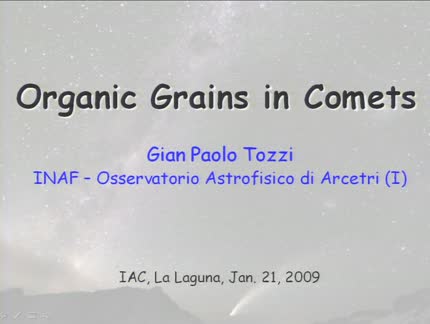Found 4 talks width keyword astrobiology

Abstract
The Square Kilometre Array is intended to be the centimeter- and meter-wavelength telescope for the 21st Century. Originally proposed as the "hydrogen telescope," the science case is now recognized to be much broader, and the SKA will address fundamental questions in astrophysics, physics, and astrobiology. The international science community has developed a set of Key Science Programs: (1) Emerging from the Dark Ages and the Epoch of Reionization; (2) Galaxy Evolution, Cosmology, and Dark Energy; (3) The Origin and Evolution of Cosmic Magnetism; (4) Strong Field Tests of Gravity Using Pulsars and Black Holes; and (5) The Cradle of Life & Astrobiology. I highlight how the SKA's Key Science Programs will be an integral component of the multi-wavelength, multi-messenger frontiers for astronomy and how the science pathfinding for the SKA is beginning now.

Abstract
In this talk we present spectroscopy of asteroids 24 Themis and 65 Cybele in the 2-4 μ region obtained with the NASA 3.5m IRTF telescope. Their spectra are very similar, and present the typical water ice band at 3.1 μ and additional absorption bands in the 3.2-3.4 μ region that can be attributed to solid organics, showing that there is a small amount of water ice and solid organics widely distributed across their surface. Spectra in the 6-25 μ region obtained with SPITZER of 65 Cybele also show that its surface is covered by a fine anhydrous silicate grains mantle as other outer belt asteroids like the Trojans are. This dust mantle, with a small amount of water ice and complex organic solids, is similar to comet surface where non-equilibrium phases coexist. The presence of water-ice and anhydrous silicates is indicative that hydration did not happened or is incomplete, suggesting that the temperatures were always sufficiently low. This is the first detection of water ice and and solid organics in the surface of an asteroid and suggest that these materials are much more abundant than expected in the surface of asteroids with semi-major axis a > 3 AU. The cosmogonical and astrobiological relevance of this discovery will be discussed.
Abstract
Comets may have played an important role in depositing the organic matter that, between 4,6 and 3,6 billion of years ago, allowed the formation of life on the primordial Earth. Nowadays, many complex organic molecules are routinely observed in the gaseous component of the comae by radio and near-IR observations. However a large quantity of organic matter may be under the form of solid, either as organic grains or organics embedded in silicate grains. The Giotto mission to the 1P/Halley comet revealed for the first time the in-situ presence of organic grains, that accounted for almost 50% of the mass of organic matter in its coma. Remote detection of these organic grains in other comets is very difficult because they rapidly sublimate under the solar radiation and their spectroscopic signatures are hidden within those of the refractory cometary dust. In this talk I will give a short review on the organic matter in comets, I will describe a method for detecting organic grains in comets and I will present recent results.

Abstract
The role of asteroids and comet impacts on the origin of Earth’s water and organic molecules is reviewed. Earth is believed to have formed dry, and magma oceans probably destroyed any primordial organics on Earth. The oldest clear evidence for water on Earth is about 3.85 Ga, right after the “Late Heavy Bombardment” (LHB). Asteroid and comet impacts during the LHB probably contributed significantly to Earth’s water and organic inventory. Evidence for this contribution is found in the D/H isotopic ratios of meteorites and comets. The abundance and variety of organic solids in asteroids and comets also point at a significant contribution to the organic inventory of the early Earth. However, the pieces of this puzzle do not all fit into a neat picture and several questions remain unanswered.
« Newer Older »
Próximas charlas
- Classical Be stars - Constraining binary interaction physics in massive starsDr. Julia BodensteinerThursday April 25, 2024 - 10:30 GMT+1 (Aula)
- Runaway O and Be stars found using Gaia DR3, new stellar bow shocks and search for binariesMar Carretero CastrilloTuesday April 30, 2024 - 12:30 GMT+1 (Aula)








